
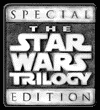

Directed by George Lucas
Produced by Rick McCallum and Ned
Gorman
INDUSTRIAL LIGHT & MAGIC
Visual Effects Supervisors: Dave Carson, John Knoll, Steven
Williams, Bruce Nicholson and Alex Seiden
Visual Effects Producer: Tom Kennedy
Visual Effects Consultant: Dennis Muren
CG Supervisors: Joe Letteri and John
Berton
The impetus of the STAR WARS project was the
desire
to restore of the classic film for its 20th Anniversary. Lucas and Fox jumped at the
chance to re-release all three films in grand fashion, adding and enhancing certain
visual effects shots.
Certain effects shots from the film have been completely replaced using digital
technology, while others use original photography as plates for brand new background
and foreground elements. With a few exceptions, the new and enhanced shots fit
seamlessly into the classic sci-fi flick.
The first of the brand new shots is a gorgeous establishing shot of R2D2 on Tatooine,
just before the Jawas capture him. The shot begins on a stunning Tatooine sky at
dusk, and tilts down to the lonely droid navigating the Tatooine surface.
In addition to the new R2 establishing shot, two more new 'replacement' establishing
shots were made for Obi-Wan's home and Luke's moisture farm. The 1977 Obi-Wan
establishing shot was an odd, nondescript, low angle of Luke's speeder parked outside
a hut. This new shot is very wide and beautiful, featuring a lot of great colors and
textures of the Tatooine surface. A slight zoom was added to the shot--if the
artists had created a dolly-in instead of a zoom, the shot wouldn't have fit into the
film. If you look carefully at the original film, there are very few dynamic camera
movements, like cranes and dollys. The other establishing shot is an extended wide
shot of Luke's farm. Using the original 1977 shot, the artists shrunk the footage,
and added more sky, more of the Jawa's cruiser and more of Luke's farm in this
breathtaking shot.
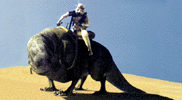
An isolated shot of the new CG Dewback and CG Stormtrooper. The background plate is
a new shot, photographed in Yuma, AZ. Notice the slight highlight added to the
trooper's helmet, consistent with the filters used back in 1977 for Tatooine scenes.
|
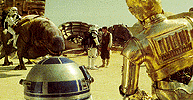
A CG Stormtrooper dismounts from a CG Dewback in this enhanced shot. The animation
of the Trooper getting off the beast is phenomenal.
|
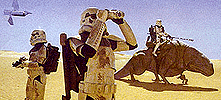
The first shot of the search sequence features real Stormtroopers and the synthetic
Dewback and trooper in the background, along with an Imperial craft zooming across
the sky.
|
Searching for the C3PO and R2D2, Imperial Stormtroopers use Dewbacks to help in the
search. Originally, the scene consisted of a single shot of a Stormtrooper on an
unmoving Dewback far in the distance--then the camera pans left to two troopers in
the foreground. The sequence is now three shots long, with two brand new shots using
newly shot Stormtrooper footage in Yuma, Arizona (the original photography took place
in Tunisia). The two brand new shots feature fully computer generated Dewbacks with
CG Stormtroopers riding them. The CG models look great, and the compositing of these
two shots have the same 'look' as the original 1977 photography. The last shot is
the 1977 pan, but instead of the immobile Dewback in the distance, we now see fully
mobile CG Dewbacks and Stormtroopers. The CG elements and plate photography are
perfectly married together.
A great new tigher shot of the Jawa's land cruiser is included in the Special
Edition, replacing a very long, wide shot of the same cruiser.
Many of Luke's landspeeder shots (around 6 in all) have been 'fixed'--the orange
optical blur underneath the floating speeder from the 1977 version has been erased
and a new shadow was created.
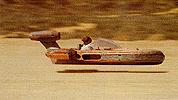
The enhanced landspeeder shots (4 in all) add the illusion of the floating craft.
|
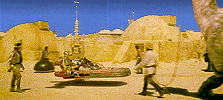
This enhanced shot features a man walking a Ronto (frame left) and the elimination of
the orange distortion pattern underneath the floating landspeeder.
|

A speeder-bike nearly hits a Ronto as its Jawa riders get flung off the beast
in this all-new shot from the Mos Eisley sequence.
|
Luke, Obi-Wan Kenobi and the two droids then venture off to Mos Eisley, Tatooine's
bustling spaceport. The new Mos Eisley sequences feature both completely brand new
shots as well as many brilliant enhanced shots.
The first is a brand new wide shot of the spaceport--the view that Obi-Wan and the
gang sees as Kenobi calls it "a wretched hive of scum and villany." Spacecraft can
be seen zooming in and out of the port, and the buildings look a lot more dense in
this great establishing shot.
The landspeeder zooms over the camera into the city in another replacement shot.
Instead of a blank sandy surface, many tiny creatures are seen hanging around the
city--the Mos Eisley equivalent of pigeons. The design is very cute and the
animation is really nice as the landspeeder zooms overhead, although it was quite
apparent that the effect was accomplished in post-production. The contrast levels
seemed a bit too high--the animals didn't seem as if they were actually in front of
the camera.
The hero shot of the sequence appears next, as a completely new shot begins on two
fighting droids, follows the landspeeder with a pan right, and cranes up, dozens of
feet above the ground, allowing the audience to see the large, bustling city for the
first time. The animation of the two droids (one a human-like droid and the other a
floating probe droid) is fanatstic and quite funny. Numerous CG elements made up the
shots, along with many digital matte paintings and miniatures. Although the shot
technically and aesthetically brilliant, it simply does not fit into STAR WARS. The
establishing crane shot is a standard in many films, but the 1977 version of STAR
WARS had very little camera movement.
Another five shots follow (some brand new, some enhanced), and many include new,
thirty foot tall creatures, called Rontos. The animation and models of these CG
models look fantastic, and compositing of these shots integrated them into the plate
photography. If the Ronto's shape looks familiar, it should--it's actually a altered
version of the CG model created for JURASSIC PARK's Brontosaurus, hence the name
Ronto. In a few other shots outside the cantina, CG Rontos and Dewbacks, along with
the floating Imperial droids are featured in the backgrounds of original 1977
photography. The match-moving and rotoscoping of these shots are
fantastic--the shadows created for the floating droid are right on the money
and are completely integrated into the 1977 shot.
The CG Stormtrooper makes another appearance in an enhanced shot--the Stormtrooper
dismounts from the Dewback in some of the best humanoid CG animation I've ever seen.
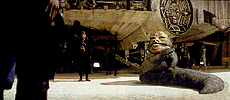
Jabba the Hutt makes a cameo in STAR WARS in this newly restored sequence.
|
One of the biggest new scenes is the restored conversation between Han Solo and Jabba
the Hutt. Originally shot with a human actor as Jabba, CG Supervisor Joe Letteri and
animator Steve "Spaz" Williams replaced him with a fully CG Jabba slug, as he
appeared in RETURN OF THE JEDI. This Jabba can slithers and squirms his way to Han,
and has a discussion with Solo in the 5 shot sequence. Small alterations to Harrison
Ford's movements were made to accomplish a seamless (and sometimes very funny)
encounter between the human and the CG creature. A new feature to the sequence is
Boba Fett--an actor in costume performed in front of a bluescreen in order to
integrate the bounty hunter into the sequence. One problem I have with the new Jabba
sequence is Jabba's eyes. The bright orange eyes of the puppet Jabba in JEDI are
realized in the new shots as glossy, desaturated bulbs. Also, Jabba is far too
expressive in this chapter of the STAR WARS saga, which betrays the way Jabba appears
in RETURN OF THE JEDI.
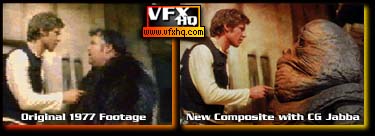
An exclusive side-by-side comparison of the 1977 production footage and the newly
enhanced shot including a computer generated Jabba. Careful erasure of the original
actor as well as extensive rotoscoping and animation of Solo add to the realism of
the sequence.
|
As the Falcon takes off from Mos Eisley, one brand new shot shows a CG Falcon rising
from Bay 94, and an enhanced wide shot of the Falcon zooming into the air features a
new, dynamic aerial move. As the Falcon tries to escape the Death Star's tractor
beam, new, accurate camera shake animation was added to the interior shots.
A new explosion was shot for Alderaan's destruction, and features a colorful
shockwave, very similar to ILM's shockwave created for STAR TREK VI. The Death
Star's explosion was enhanced with this shockwave, as well.
A terrific enhanced shot was created for Han Solo's furious attack on a group of
Stormtroopers. In the original shot, eight Stormtroopers turn around and fire on
Solo. In the hilarious enhanced shot, an entire legion of Stormtroopers appear in
the background.
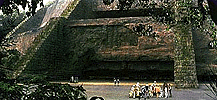
In this incredible composite, the Rebel base exterior has been enhanced, giving the
huge structure a new, rougher exterior.
|
No new model photography was used for space sequences for the Special Edition of STAR
WARS--all spacecraft were created as CG models. Textures were scanned directly off
of the original miniature models created in the late '70's, however. CG
representations of the Millennium Falcon, the X- and Y-Wing fighters, as well as TIE
Fighters will appear onscreen.
Intending to keep the pacing of the original film intact, the effects artists crafted
each new space shot (around 30) to be the same frame length as the original shot.
The choreography of the shots in question was enhanced--the new CG craft afford the
animators a greater range of movement than the motion-control shot models. Instead
of a limited three dimensional space for which the camera and the model to interact
(due to stage size, model and camera rigging, etc.), the virtual camera and virtual
model have infinite possibilities in terms of distance and perspective. New,
exciting dynamics have been created to enhance the sequences' drama, not alter
them.
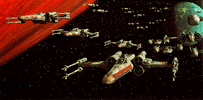
The 'hero' X-Wing shot begins with a quarter angle of CG X- and Y-Wings approaching
the camera...
|
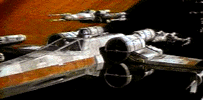
...until we can clearly see the pilot and R2 units...
|
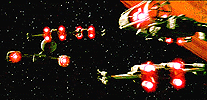
...and doesn't end until the camera pans left to see the ships pass the camera.
|
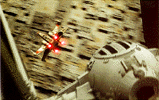
Many shots of the final battle sequence were re-made with more dynamic aerial
manuevers.
|
The enhanced shots make the final sequence much more dynamic and smooth out the rough
edges of the battle.
All in all, the new and enhanced shots fit very well into the sci-fi classic. Lucas
and ILM have expanded the STAR WARS universe and allowed the audience to witness the
director's original vision.
Read the VFX HQ News Article: STAR WARS Strikes Back
Check out Cinefex 69.
Check out American Cinematographer Feb. '97.
Official Web Site: http://www.starwars.com
Back to the STAR WARS Main Page

. . VFX HQ Produced by Todd Vaziri . . http://www.vfxhq.com . . e-mail: tvaziri@gmail.com . .
All text Copyright © 1998 Todd Vaziri, unless otherwise noted















